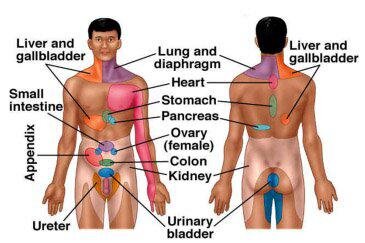Visceral Referred Pain
The effects of trigger points and their referred pain have been well documented. Muscles with active trigger points will often refer pain to other areas of the body. But did you know that your internal organs, known as viscera, can do the same? Could the pain in your left shoulder actually be referred pain coming from your lungs and diaphragm? In this article we’ll take a closer look at the effects of visceral pain, as well as underscore the importance of staying on top of your health and going for regular check ups.
Very little is known about visceral pain and the mechanisms behind its manifestations. Apart from the occasional abdominal pain, which be could the result of indigestion or cramping for example, we give very little thought to what its true source may be. The most common example of referred visceral pain comes in the form of cardiac pain. Ischemic compression of the heart, whether it’s angina or the beginnings of a heart attack, could manifest as pain along the sternum, the left side of your chest, down the inside of your left arm, and up into your left jaw. This is a very specific and unique referral pattern and one that most of us would be alarmed by. But some visceral pain can be as insidious and commonplace as an ache or pain in your shoulder. This makes determining its root cause all the more difficult.
One of the many theories behind visceral referred pain is known as ‘viscero-somatic convergence.’ Surprisingly, there is a lack of dedicated sensory pathways linking your internal organs with your brain. Nociceptors, the sensory neurons that detect pain, in the viscera will often converge with signals coming from the sensory pathways of your skin and muscles. When this happens, the brain will perceive the pain as coming from a different area of the body. Let’s take a look at some of the most common referral sites for visceral pain and dysfunction:
Right neck and shoulder:
-Liver and gallbladder
Left neck and shoulder:
-Lungs and diaphragm
Sternum, left chest, inside of left arm, left jaw:
-Heart
Right lower abdomen:
-Appendix
Mid-back along the spine & just below your scapulas:
-Stomach
Right side of ribcage just below your pectoral muscle:
-Liver and gallbladder
Left side of abdomen just below sternum:
-Pancreas
Abdominals above navel:
-Small Intestines
Abdominals below navel:
-Colon
Lower back & abdominals, inner & outer sides of thighs:
-Kidneys
Pubis:
-Urinary bladder
It’s important to remember that not all of your internal organs have pain receptors. The hollow organs such as the stomach, intestines, bladder, and uterus for example, are some of the ones that do. All of your organs however, have receptors that can detect pressure, ischemia, inflammation, and noxious chemicals. So in most cases, visceral dysfunction will often manifest first through the autonomic nervous system as a dull, diffuse, and hard to locate form of discomfort or pain.
So how does one determine whether the source of the pain is visceral or muscular? Without a yearly physical or regular checks up with your doctor, it can be difficult to determine. If the pain and discomfort is long-term and unremitting despite your best efforts to address it, whether it be massage, rest, or some other means, then it may be time to speak to your doctor.

